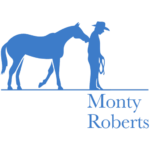Excerpt from Chapter 9 of Monty’s textbook, From My Hands to Yours
To obtain your own copy of Monty’s textbook, please CLICK HERE.
Traditionally, in the extrinsic method of training, a horse is put into a starting gate with a few others he is going to compete against. Next, a button is pushed which causes the gates to fly open, thereby freeing the horses to run forward. Often, the trainer encourages the horse by hitting him on the hips or the hocks the moment the gates are released. The jockey might use both vocal and physical “persuasion” to press the horse forward into immediate flight.
To train a horse intrinsically, I have revised the first experience. The horse should be quietly walked into his gate, placing him next to one or two more experienced horses. When the gates are opened, everyone remains silent. The older horses leave immediately, while the younger, inexperienced one might dwell, not knowing what is expected of him. He will usually watch the other horses as they leave and generally follow, even if quite tentatively.
The riders on the older horses will have been instructed to just canter at a slow pace. Once the young horse is 50 feet (approx. 16 meters) or so clear of the gate, then, and only then, should his rider begin to encourage him to go forward at a higher rate of speed. The young horse will see the older ones and perceive them as competition. He will begin to run faster and his rider will press him past the slow-moving horses, causing him to think that he is the victor. The next time the young horse is taken to the starting gate, he is likely to view it as fun. As he enters the gate, his mind will probably be thinking forward, remembering the competition, and be ready to go again.
The horse trained extrinsically will probably be reluctant to go into the gate. Once he is forced, the horse trained in this manner will be nervous and unruly. His mind is likely to be thinking backwards. He is likely to concentrate on his hip or hocks, where the whips were applied previously. It is at this point horses will often tend to incriminate the footrails and will develop a phobia against them. The intrinsically motivated horse is happy to go into the gate and looks forward to competing.
During the second session, he still finds his rider remaining quiet. When the gates spring open, this young horse reacts more quickly, and passes the older horses earlier than he did the first time. I find that three or four of these educational sessions will produce a racing prospect that is far more effective at the starting gate than the extrinsically motivated individual.

Above: Nine men could not push or pull Lomitas into the starting gate once he identified it as a terrifying monster. The race was run without him and he was banned from racing worldwide.
In 1991, I was called to Germany to deal with a three-year-old Thoroughbred. Lomitas was a beautifully conformed, well-bred chestnut that had earned the title, “Champion Two-Year-Old in Germany” in 1990. Due to circumstances not entirely known to me, Lomitas had obviously concluded that starting gates were a dangerous place to be, and he was willing to fight tenaciously against entering them.
Nine men were unable to achieve loading through force. I met him, did Join-Up with him and convinced him through communication and trust that there was no reason to fear the starting gate. Lomitas was the 1991 Horse of the Year in Germany, and the highest-rated horse ever produced in that country through his performances and earnings.

Above: After working with Monty for one month, Lomitas returns to his career as a racing horse and goes on to become the highest-rated horse ever produced in Germany through his performances and earnings.

